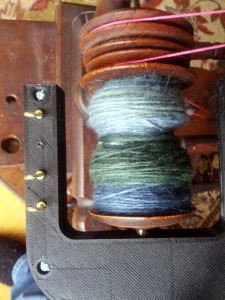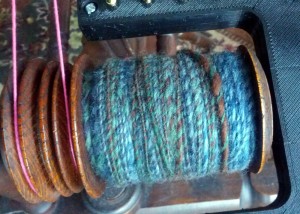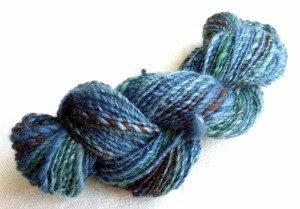The Husband strikes again! This time he was taking the adventurous, scenic route home from a shopping trip and came across an interesting looking estate sale. I was off knitting with friends, so I received text messages like… “how do you know if a spinning wheel works or not?”, “take a look at this pic”, and “does it have all of the parts?” I don’t know! I just took a drop spindle class in January, I haven’t used a spinning wheel yet. He was too impatient for real, researched answers so he wandered off.
 Meet Penelope, the newest addition to my fibery machine family. He liked her so he brought her home anyway. It’s a good thing he’s not a dog/cat rescuer – we’d be overrun with animals. It turns out that I like her too, so it was a sweet deal.
Meet Penelope, the newest addition to my fibery machine family. He liked her so he brought her home anyway. It’s a good thing he’s not a dog/cat rescuer – we’d be overrun with animals. It turns out that I like her too, so it was a sweet deal.
I spent the next day on the Internet looking up everything I could about antique spinning wheels – styles, construction, parts, how they work, care and feeding, etc. From what I can tell, this is a saxony style wheel with Nordic/Scandinavian details. Not surprising, with the large Nordic heritage in the communities here. There is no maker’s mark, so I don’t know where it was manufactured or when. What I did determine very quickly is this: it’s a functioning wheel that’s missing some key parts. The experts say this isn’t unusual with an antique wheel. The drive band is gone, but easily replaceable. The flyer is also missing, but the spindle, orifice, whorl, and bobbin are still present and functional.
Since the spindle is still there, we thought it might be easy to make a new flyer. Yes, it really needs to be balanced and all that. And yes, it should be done by a professional. But I am not a professional spinner. I’m a tinkerer, and just want to figure it out. So I took some measurements and made a drawing. Husband took my drawing and worked it up on the computer, then spit it out on his 3D printer. Any excuse to use the printer! I took the same drawing and made a crude one out of wood.
 I threaded the wheel with a new drive band made of some leftover cotton yarn I had in the stash. The Internet suggested this as the preferred method, as the bands stretch out with use and need to be replaced frequently anyway. Then we compared our flyers. Mine was unusable, as the bore hole I made slipped around the spindle. The hole for the spindle needed to be square to match the spindle shaft where they meet. Husband’s printed flyer works much better, as it was made in two parts then screwed together so it fits tightly around the spindle. I added some cup hooks along one side and away she went!
I threaded the wheel with a new drive band made of some leftover cotton yarn I had in the stash. The Internet suggested this as the preferred method, as the bands stretch out with use and need to be replaced frequently anyway. Then we compared our flyers. Mine was unusable, as the bore hole I made slipped around the spindle. The hole for the spindle needed to be square to match the spindle shaft where they meet. Husband’s printed flyer works much better, as it was made in two parts then screwed together so it fits tightly around the spindle. I added some cup hooks along one side and away she went!

 Penelope and I have since figured out how to work together. The wheel needs a balance of tension, speed, and rhythm and I’m still perfecting each part of the equation. For my first try, I spun some lovely painted BFL (Bluefaced Leicester – a specific sheep breed) into a variegated two-ply yarn. It’s so soft and fluffy that I think I’ll knit it up into a pair of fingerless mitts for myself.
Penelope and I have since figured out how to work together. The wheel needs a balance of tension, speed, and rhythm and I’m still perfecting each part of the equation. For my first try, I spun some lovely painted BFL (Bluefaced Leicester – a specific sheep breed) into a variegated two-ply yarn. It’s so soft and fluffy that I think I’ll knit it up into a pair of fingerless mitts for myself.

